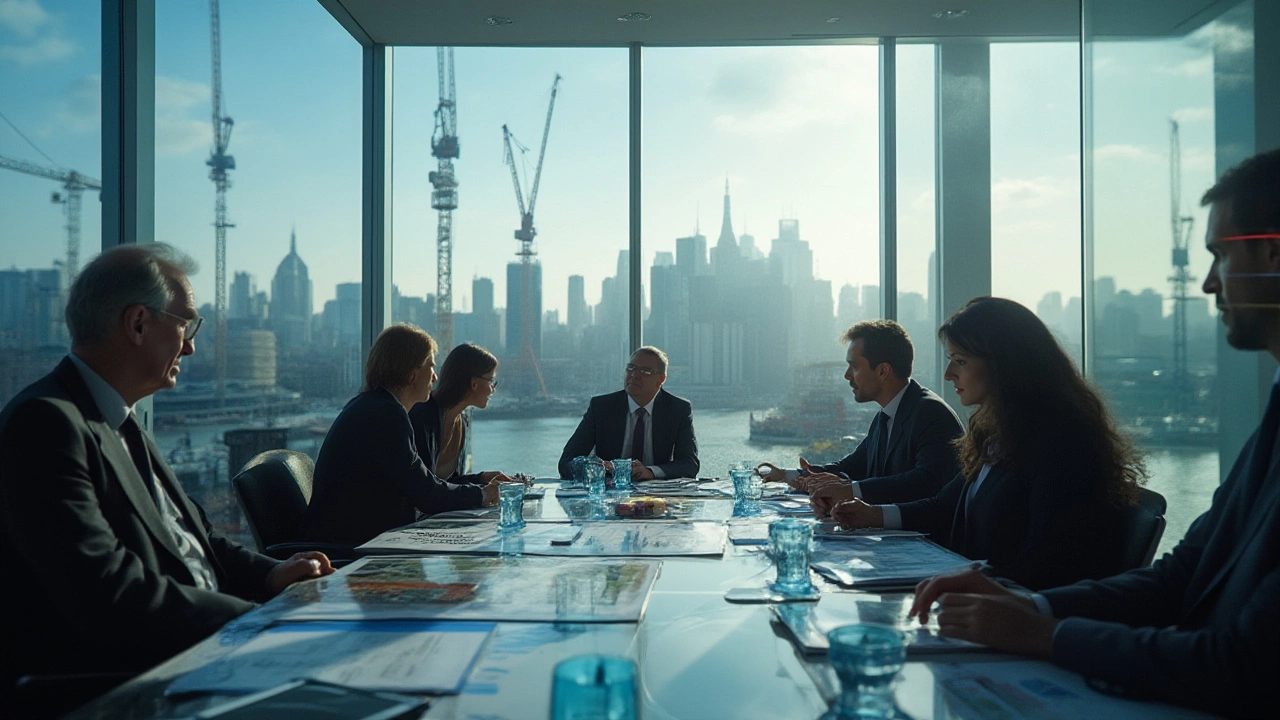World’s Most Valuable Construction Companies: Who Tops the List in 2025?
 Jul, 24 2025
Jul, 24 2025
Ever wondered which construction titan builds more than just skyscrapers, but massive wealth? The answer can surprise even folks in the business. The race to be the world’s most valuable construction company is not just about pouring concrete and hanging steel. It’s about pulling off mega-deals, managing mind-bending risks, and making clients across the globe trust them with projects worth billions. In 2025, the numbers are head-spinning—and the story behind those numbers is even wilder.
The Crown Jewel: Who’s Really Worth the Most?
Let’s get straight to the money. China State Construction Engineering Corporation (CSCEC) is still the undisputed heavyweight champion. We’re not just talking about a couple extra zeros—their valuation floats near $230 billion (yes, billion with a ‘b’). That means CSCEC is bigger than some countries’ entire economies. How does a company even get that large? It’s all about scale. CSCEC isn’t just building a new neighborhood, they’re building entire cities, rail systems, airports… sometimes all at once. Think about this: Right now, if you’re reading this in a brand-new apartment in urban China, there’s a jaw-dropping chance these folks had a hand in it. In fact, as of 2025, nearly 1 in every 13 construction workers in the world is on a CSCEC project. And their backlog? It’s the kind of number that mostly lives in science fiction: over $400 billion in pending projects.
But CSCEC doesn’t rule alone. Want proof that the race for the top isn’t just a one-horse show? Let’s talk about Vinci SA from France. This European juggernaut is consistently worth $90-110 billion, depending on how the market’s feeling. Vinci specializes in high-profile civil engineering—bridges, highways, stadiums—think of them as the reliable old pros who’ve helped modernize most of Western Europe. They’re the ones behind France’s modern airports and the company that has literally paved the way across the continent.
Can you ignore the U.S. heavyweights? Not a chance. The U.S.-based Bechtel isn’t publicly traded, so their worth is always a bit mysterious, but in 2025, estimates put them at $50-55 billion. They build everything from half the U.S. nuclear missile silos to Silicon Valley’s shiniest tech campuses. If there’s a technology boom, or a government megaproject, you can bet they’re in the mix.
A couple of fun facts: Spain’s Grupo ACS hovers around the $40-50 billion mark, with an epic international reach. Germany’s Hochtief, which is actually a subsidiary of ACS, is everywhere from Europe to Australia. It’s a tangled web of subsidiaries—these giants often own large chunks of each other, making financial rankings a challenge. The bottom line? CSCEC still holds the crown, but the pack behind them is a global mashup fighting hard to catch up.

What Makes a Construction Company So Valuable?
The worth of these behemoths isn’t just about how many buildings they finish. You can’t just add up the cranes and dump trucks; there’s a lot more going on. Start with revenue: CSCEC, for example, brought in over $300 billion USD in 2024, dwarfing rivals. But revenue is only the surface. Real value is built on contracts, assets, reputation, and even political clout.
The biggest companies have their fingers in every construction pie you can imagine. They handle commercial contracts, massive government deals, and private sector work in energy, logistics, and more. That diversity is key. Let’s take Vinci again—during economic booms, their private contracts soar. In tough times, government infrastructure spending keeps the lights on. Smart, right?
Another factor: Risk management. When you’re dealing with deals worth billions, one bad move can tank a year’s profit. These giants run some of the sharpest risk teams in the business—estimating costs, planning for every disaster, sometimes even getting ahead of hurricanes or government coups. For example, Bechtel is famous for pulling out of risky markets just before things go south, and pivoting to somewhere safer. That’s not luck— that’s decades of reading political winds and having local intel everywhere they go.
Geography plays a role too. Companies rooted in China and the Middle East have an edge with relentless local government support, cheap financing, and a never-ending hunger for new cityscapes. Meanwhile, U.S. construction depends a lot on the private sector, while Europe is a mix. The point? It’s easier to build a giant business when your home government is a client for life and lines you up with steady work. It’s the world’s priciest form of job security.
Then there’s the know-how. These companies don’t just throw up concrete shells; they specialize in complex “turnkey” projects—smart cities, metro tunnels under busy high-rises, energy grids that keep entire countries running. Reputation matters. Vinci and Hochtief both landed 10-year contracts for Europe’s bullet-train upgrades based almost as much on trust as price. If they miss a deadline, it’s not just a loss, it’s a scandal. Think about it: One mistake can go viral worldwide, slicing billions off the share price.
The final piece? Scale. These companies gobble up smaller construction firms the way a blue whale eats krill. Acquisitions help them grab new tech, snatch up fresh building sites, and stay one step ahead. The phrase “too big to fail” takes on a whole new meaning in construction; if any of these big dogs fell, it would throw infrastructure planning into chaos across entire continents.

Why Does This All Matter—And What Can We Learn?
Some people might shrug and say, “So what if CSCEC is gigantic?” But this isn’t just about bragging rights or financial trivia. The reach of the world’s most valuable construction companies shows exactly where the world is heading. Right now, billions of dollars are pouring into urbanization. Most city skylines today—Shanghai, Dubai, even parts of Sydney—didn’t exist twenty years ago. These companies are literally shaping how billions will live, travel, and work. Their investments whisper what the next big thing will be: underground transit for mega-cities, green skyscrapers powered by their own wind turbines, or automated factories that build houses faster than humans ever could.
If you follow the money, you spot trends before anyone else. For instance, watch the rush toward sustainable construction. Vinci’s 2025 investment in carbon-neutral roads? That’s not just good PR—soon, governments across the globe will want climate-friendly builds. The big guys are eating up smaller, eco-focused construction tech companies to stay ahead of change. CSCEC, for its part, announced that its next goal is using AI-driven site management nationwide. When companies worth hundreds of billions pivot, the ripple effect shapes what the whole industry does next year.
Here’s a tip for anyone considering investing, working, or collaborating in construction: size matters—but so does agility. The largest companies might be slow to turn, but when they do, they can move entire markets. Meanwhile, sharp smaller firms can innovate and get bought out just as quickly. If you’re eyeing a piece of the pie, consider both approaches. Maybe you want a job with stable pay and projects everywhere from Vietnam to Canada; go for the giants. Or maybe you want to join a nimble crew where you can make huge waves fast—those smaller, up-and-coming companies are always hunting for disruptors and fresh ideas (and paying surprisingly well for them).
Also, the next time you drive on a new motorway, hop on a bullet train, or check in at a high-rise hotel, check the brass plaque or the hardhats on site. Chances are, the name belongs to one of these mega-builders. They make the modern world possible—from the homes we live in, to the stadiums we cheer in, to the infrastructure standing quietly behind the scenes when we assume everything will just work. Knowing who they are, and what makes them valuable, isn’t just trivia—it’s a window into the future of how we’ll actually live every day—for decades to come.
